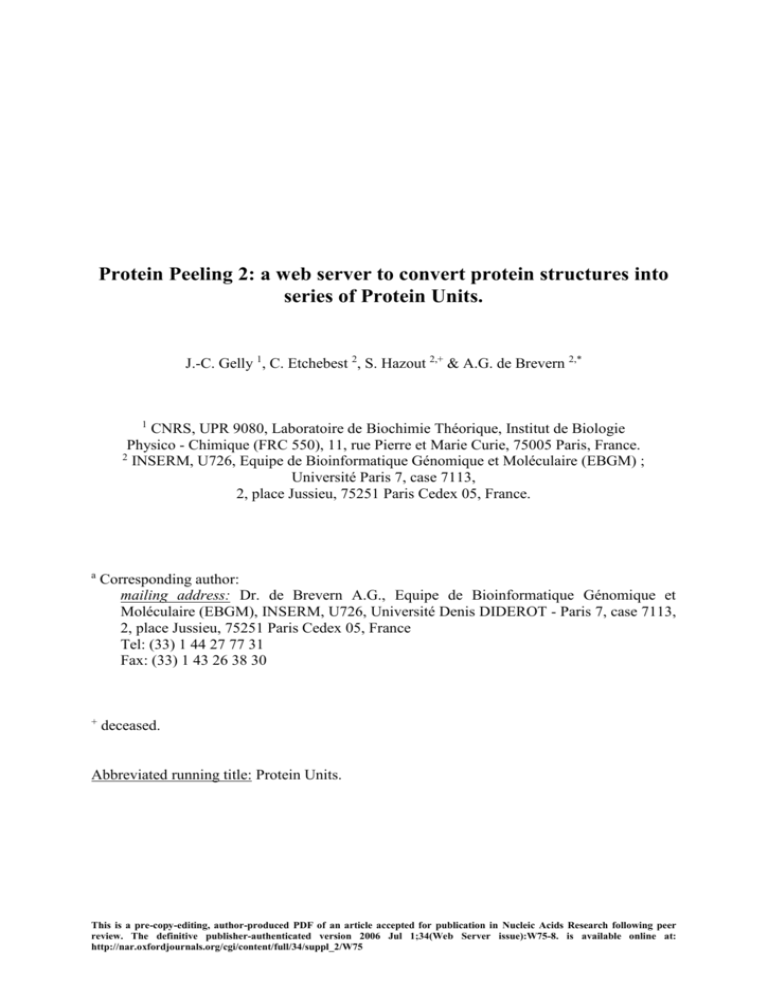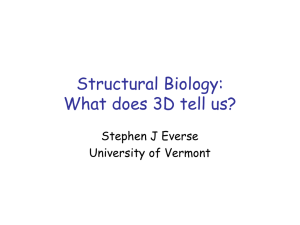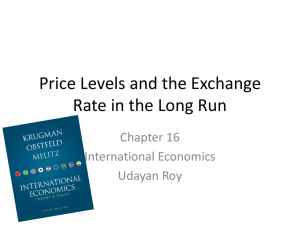"Pinning strategy": a novel approach for predicting the - HAL
advertisement

Protein Peeling 2: a web server to convert protein structures into series of Protein Units. J.-C. Gelly 1, C. Etchebest 2, S. Hazout 2,+ & A.G. de Brevern 2,* 1 CNRS, UPR 9080, Laboratoire de Biochimie Théorique, Institut de Biologie Physico - Chimique (FRC 550), 11, rue Pierre et Marie Curie, 75005 Paris, France. 2 INSERM, U726, Equipe de Bioinformatique Génomique et Moléculaire (EBGM) ; Université Paris 7, case 7113, 2, place Jussieu, 75251 Paris Cedex 05, France. a Corresponding author: mailing address: Dr. de Brevern A.G., Equipe de Bioinformatique Génomique et Moléculaire (EBGM), INSERM, U726, Université Denis DIDEROT - Paris 7, case 7113, 2, place Jussieu, 75251 Paris Cedex 05, France Tel: (33) 1 44 27 77 31 Fax: (33) 1 43 26 38 30 + deceased. Abbreviated running title: Protein Units. This is a pre-copy-editing, author-produced PDF of an article accepted for publication in Nucleic Acids Research following peer review. The definitive publisher-authenticated version 2006 Jul 1;34(Web Server issue):W75-8. is available online at: http://nar.oxfordjournals.org/cgi/content/full/34/suppl_2/W75 Protein Units ABSTRACT Protein Peeling 2 (PP2) is a web server for the automatic identification of Protein Units (PUs) given the 3D coordinates of a protein. PUs are an intermediate level of protein structure description between protein domains and secondary structures. It is a new tool to better understand and analyze the organization of protein structures. PP2 only uses the matrices of protein contact probabilities and cut the protein structures optimally using Matthews’s coefficient correlation. An index assesses the compactness quality of each PU. Results are given both textually and graphically using JMol and PyMol softwares. The server can be accessed from http://www.ebgm.jussieu.fr/~gelly/index.html. 2 Protein Units INTRODUCTION Even with no relation with the folding process, folded state is often described in a hierarchical way. The top is frequently associated to domains, i.e. autonomous folding units (1) and the bottom to secondary structures (2,3). In the middle, super - secondary structures are frequently identified. Such descriptions are mainly based on frequency of similar motifs, described at different levels of 3D complexity. Many experiments and recent theory of protein folding suggest that the 3D folded state would dictate the folding process. Yet, only few approaches aim at identifying folding features through the analysis of the folded state. In a pioneer work, Wetlaufer was the first to examine the organization of known structures and suggested that the early stages of three-dimensional structure formation, i.e. nucleation, occur independently in separate parts of these molecules (4). He referred to these domains as Folding Units (5) and suggested that they could fold independently during the folding process, creating structural modules which are assembled to give the native structure (6). Early analysis were often done manually and on a limited number of proteins (4,7-9). Since then, different strategies have been designed for extracting such folding units. The procedures differed in many aspects, for example the measures and the criteria used. Gō (10) for instance based his description on the C- C distance map. Janin and Wodak defined putative compact globular units as units with minimal interface area (11). Rose (12,13) identified a disclosing plane that cut the protein chain into compact continuous segments. Subsequently, Zehfus (14) reported an algorithm, extending earlier work by Zehfus and Rose (15) that identified compact structures, and located discontinuous domains in four globular proteins. Sowdhamini & Blundell’s approach was based on C- C distances and secondary structures (16). Tsaï & Nussinov described a scoring function, based on compactness, hydrophobicity and isolatedness, that estimates the stability of these units (12,17). These 3 Protein Units different automatic approaches define a hierarchical organization of the protein in compact units (11,12,16-18). However, only few servers are accessible to the scientific community at this time. Moreover, they mainly focus on the top level of organization, namely, protein domains, for instance Protein Domain Parser (19). DIAL, another web tool, focused on automatic identification of structural compact domains given the 3D coordinates of a protein; it extends the detection of other hierarchical levels of three-dimensional organization of protein structure (20) compared to the previous one. In the present paper, we propose a new Web-server, called Protein Peeling 2 (PP2), aiming at describing different levels of organization of 3D protein structures, depending on the user choices. PP2 is based on a new methodology, able to decompose the 3D protein structure from secondary structures to domains. The procedure may yield an intermediate level of organization, through what we have named, Protein Unit (PU). A PU is defined as a compact sub-region of the 3D structure corresponding to one sequence fragment, defined by a high number of intra-PU contacts, and, a low number of inter-PU contacts. Protein Peeling works from the C-contact matrix translated into contact probabilities (21). An optimization procedure, based on the Matthews’ coefficient correlation (MCC) (22) between contact submatrices, defines optimal cutting points that separate generally into 2 or 3 PUs, the region examined. The process is iterated until the compactness of the resulting PUs reaches a given limit, fixed by the user. The PU compactness is quantified by an index CI for compaction index. This index is based on a correlation coefficient R between the mutual entropy of the contact sub-matrices (23-25). The procedure leads to cut the 3D protein structure into a limited set of PUs. Thus, it defines a series of successive nested partitions; i.e. a dendogram showing the successive splitting of the PUs into sub-PUs. 4 Protein Units PEELING SERVER The web server allows working with one structure (or a structural model). Using default parameters, the user upload the PDB file. The contact matrix is then computed and transformed into a probabilities contact matrix. The procedure performs the splitting of protein structures into Protein Units. The results are shown using different tools: (i) dendogram showing the successive splitting of the PUs into sub-PUs, (ii) contact matrix of the PUs, (iii) 3D representation of the PUs and (iv) summary of the different PUs. IMPLEMENTATION Figure 1 shows the flowchart representation of Protein Peeling 2 (PP2) web server. Interface component is composed of web page (HTML) and Common Gateway Interface (CGI). This interface permits to get the values given by the user (parameters and PDB file) and to transmit them to the perl core instance. The core component is so a perl module that embeds all the information necessary to reach the two other components. The first component is constituted of programs that perform the protein peeling process and compute compactness indexes. The second component consists in different rendering softwares. Thus, R software (26) is used to visualize (i) the hierarchical peeling of the protein structure, (ii) the probabilities contact matrix and (iii) the final splitting of the protein structure with its contents in secondary structures. In the same way, PP2 relies on PyMol (27). The communication between the PP2 core instance and the graphical viewer is based on the generation by the PP2 instance of a script. This component manages the post-rendering of the pictures. The conversion is based on the convert program of the ImageMagick suite (http://www.imagemagick.org). We have also added the possibility with a Java Virtual Machine to use JMol software. JMol allows 5 Protein Units visualizing the final cutting in PUs in 3D (www.jmol.org). It is possible, using such a design, to trigger the rendering by a mechanism different from CGI, for instance interactively using a command line, and to generate a databank of PUs from a non-redundant databank. Further analyses may be therefore easily carried out. PEELING SERVER FEATURES Figure 2 presents snapshots of the different information and results given by PP2 web server. Data input. PP2 supports only the PDB format. Adjustable parameters (cf. Figure 2a). PUs are split using the C-distance matrix translated in terms of probabilities. This version of our web server allows changing the C-distance threshold and the curvature of the probability function. In the same way, it is also possible to use only the regular secondary structures in the creation of the PUs. Minimal size for secondary structures and PUs can also be changed by the user. To stop the peeling process, the R-value threshold can be modified. Moreover, a pruning of the final dendogram is proposed. It permits to discard PU that presents a low number of inter-contacts, i.e. only pertinent cutting will be done. Representation of the results. During the submission process, an automatic image, generated with Rasmol (28) and representing the protein structure, is shown. After the protein peeling, each PU is characterized by its position in the protein sequence and is associated for its representation to a fixed color. At first, a summary of the different parameters used is shown (cf. Figure 2b). A dendogram representation of the peeling process details the different events (cf. Figure 2c). The contact matrix is also represented and colored according to the PUs (cf. Figure 2d). 6 Protein Units We also have added a schematic representation of the results with a description of PUs with their contents in secondary structures and a 3D visualization using JMol applet (http://jmol.sourceforge.net/) (cf. Figure 2e). This viewer allows observing the entire colored protein in terms of PUs. The user can easily interact with such a description. A classical static representation done by PyMol software (27) is also produced. The corresponding script may be downloaded locally (cf. Figure 2f). A linear representation of the PUs along the sequence is also given (cf. Figure 2g) with the corresponding colors. The precise position of the different PUs is also given in text form with the corresponding Compaction Index (CI), i.e. the index that quantifies the compactness of the PU (cf. Figure 2h). For clarity, only the last level of cutting is given. However, all the other levels are available, with the corresponding CI of each intermediate PU (cf. Figure 2i). Non-redundant databank. An updated non-redundant databank taken from the Protein DataBank (29) is also available. This non redundant set of proteins structures includes 2,309 elements from crystallographic experiments better than 2 Ǻ of resolution given by PISCES server (30). The proteins share no more than 30% of sequence identity. All these structures have been dissected with the Protein Peeling procedure. Results were stocked in a flat file database and theses pre-cut proteins could be easily accessed through a form or by selecting the protein in the list. PERSPECTIVES The PU provides a new view of the protein folded state. It offers an original and rapid way to analyze interesting regions in the structure. PP2 web server allows obtaining the composition in terms of PUs of protein structures. PP2 server is thus a useful tool to examine in an original way, the 3D structure of proteins. The different parameters may be easily controlled and the subsequent PUs graphically analyzed. Results are given both textually and visually. In the 7 Protein Units future, we would like to analyze the PUs distribution across protein families (31) and perform prediction from the sequence. ACKNOWLEDGMENTS This paper is dedicated to the memory of Pr. Serge Hazout. This work was supported in part by ACI Action Bioinformatique 2003-2004. Authors thank Institut National de la Recherche Médicale (INSERM), Université Paris 7 – Denis Diderot, Centre National de la Recherche Scientifique (CNRS) and Ministère de l'Education Nationale de l'Enseignement Supérieur et de la Recherche for financial and infrastructural supports. Conflict of interest statement. None declared. CAPTIONS Figure 1. Flowchart of the PP2 web server. Figure 2. PP2 web server. (a) PP2 interface. (b) Summary of the parameters used. (c) Tree showing the protein peeling process with the different final PUs and their positions. (d) Probability contact matrix with the cutting of the PUs. (e) JMol and (f) PyMol representation of the protein coloured according to PUs colors. (g) Linear representation of the PUs with their secondary structure assignments. (h) Sequence positions of the PUs with their CI values. (i) Previous level of protein peeling represented by PyMol software. 8 Protein Units REFERENCES 1. 2. 3. 4. 5. 6. 7. 8. 9. 10. 11. 12. 13. 14. 15. 16. 17. 18. 19. 20. 21. 22. Richardson, J.S. (1981) The anatomy and taxonomy of protein structure. Adv Protein Chem, 34, 167-339. Pauling, L. and Corey, R.B. (1951) The pleated sheet, a new layer configuration of polypeptide chains. Proc Natl Acad Sci U S A, 37, 251-256. Pauling, L. and Corey, R.B. (1951) Atomic coordinates and structure factors for two helical configurations of polypeptide chains. Proc Natl Acad Sci U S A, 37, 235-240. Wetlaufer, D.B. (1973) Nucleation, rapid folding, and globular intrachain regions in proteins. Proc Natl Acad Sci U S A, 70, 697-701. Wetlaufer, D.B. (1981) Folding of protein fragments. Adv Protein Chem, 34, 61-92. Chothia, C. (1984) Principles that determine the structure of proteins. Annu Rev Biochem, 53, 537-572. Drenth, J., Jansonius, J.N., Koekoek, R., Swen, H.M. and Wolthers, B.G. (1968) Structure of papain. Nature, 218, 929-932. Phillips, D.C. (1966) The three-dimensional structure of an enzyme molecule. Sci Am, 215, 78-90. Janin, J. and Wodak, S.J. (1983) Structural domains in proteins and their role in the dynamics of protein function. Prog Biophys Mol Biol, 42, 21-78. Go, M. (1981) Correlation of DNA exonic regions with protein structural units in haemoglobin. Nature, 291, 90-92. Wodak, S.J. and Janin, J. (1981) Location of structural domains in protein. Biochemistry, 20, 6544-6552. Rose, G.D. (1979) Hierarchic organization of domains in globular proteins. J Mol Biol, 134, 447-470. Lesk, A.M. and Rose, G.D. (1981) Folding units in globular proteins. Proc Natl Acad Sci U S A, 78, 4304-4308. Zehfus, M.H. (1994) Binary discontinuous compact protein domains. Protein Eng, 7, 335-340. Zehfus, M.H. and Rose, G.D. (1986) Compact units in proteins. Biochemistry, 25, 5759-5765. Sowdhamini, R. and Blundell, T.L. (1995) An automatic method involving cluster analysis of secondary structures for the identification of domains in proteins. Protein Sci, 4, 506-520. Tsai, C.J. and Nussinov, R. (1997) Hydrophobic folding units derived from dissimilar monomer structures and their interactions. Protein Sci, 6, 24-42. Crippen, G.M. (1978) The tree structural organization of proteins. J Mol Biol, 126, 315-332. Alexandrov, N. and Shindyalov, I. (2003) PDP: protein domain parser. Bioinformatics, 19, 429-430. Pugalenthi, G., Archunan, G. and Sowdhamini, R. (2005) DIAL: a web-based server for the automatic identification of structural domains in proteins. Nucleic Acids Res, 33, W130-132. Gelly, J.-C., De Brevern, A.G. and Hazout, S. (2006) “Protein Peeling”: an approach for splitting a 3D protein structure into compact fragments. Bioinformatics, 22(2):12933. Matthews, B.W. (1976) X-ray crystallographic studies of proteins. Annu. Rev. Phys.Chem, 27, 493-523. 9 Protein Units 23. 24. 25. 26. 27. 28. 29. 30. 31. de Brevern, A.G., Etchebest, C. and Hazout, S. (2000) Bayesian probabilistic approach for predicting backbone structures in terms of protein blocks. Proteins, 41, 271-287. de Brevern, A.G. and Hazout, S. (2003) 'Hybrid protein model' for optimally defining 3D protein structure fragments. Bioinformatics, 19, 345-353. Etchebest, C., Benros, C., Hazout, S. and de Brevern, A.G. (2005) A structural alphabet for local protein structures: improved prediction methods. Proteins, 59, 810827. Ihaka, R. and Gentleman, R. (1996) R: a language for data analysis and graphics. J Comput Graph Stat, 5, 299-314. DeLano, W.L.T. (2002) The PyMOL Molecular Graphics System. DeLano Scientific, San Carlos, CA, USA. http://www.pymol.org. Sayle, R.A. and Milner-White, E.J. (1995) RASMOL: biomolecular graphics for all. Trends Biochem Sci, 20, 374. Berman, H.M., Westbrook, J., Feng, Z., Gilliland, G., Bhat, T.N., Weissig, H., Shindyalov, I.N. and Bourne, P.E. (2000) The Protein Data Bank. Nucleic Acids Res, 28, 235-242. Wang, G. and Dunbrack, R.L., Jr. (2003) PISCES: a protein sequence culling server. Bioinformatics, 19, 1589-1591. Efimov, A.V. (1997) Structural trees for protein superfamilies. Proteins, 28, 241-260. 10








